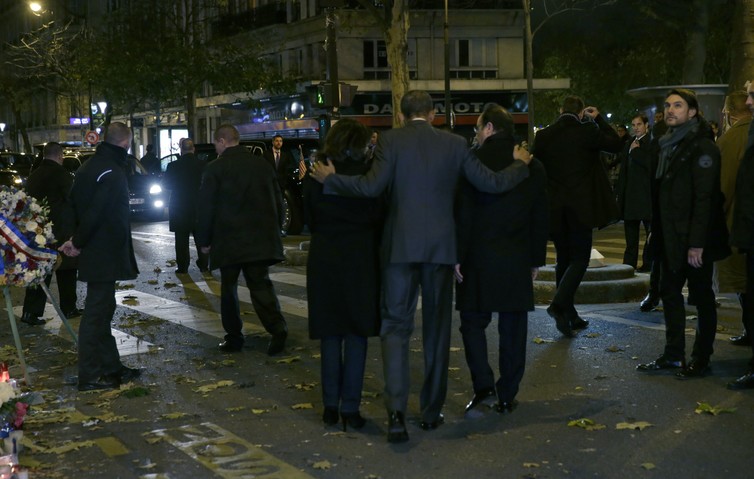Two years ago, virtually no one had heard of the Islamic State of Iraq and Syria (ISIS). In a January 2014 New Yorker interview, President Obama dismissed the group as “Junior Varsity.”
Since then, ISIS has emerged as one of the most wealthy, powerful and dangerous terrorist organizations that ever existed.
ISIS now possesses more than US$2 billion in stolen cash, thousands of captured tanks and bombs, as well as lucrative oil wells and refineries in the large parts of Syria and Iraq that it has taken over.
In these areas, the U.S. has determined, ISIS is committing genocide against Christians, Shia Muslims and Yazidis. Beheadings, burning people alive, mass rape – these are the methods of ISIS terror.
But the ISIS threat is not confined to the Middle East.
In October they bombed a Russian airliner, in November they attacked Paris and, most recently, on March 22, ISIS terrorists bombed the Brussels airport and a key train station. These attacks have left 650 Westerners dead and over a thousand injured. Any city in the world could be the target of the next ISIS attack.
As former counsel to the Counter Terrorism Bureau and attorney adviser for United Nations affairs at the U.S. Department of State, I have been lecturing and writing about the international rules governing use of force for decades.
In my 2013 book, Customary International Law in Times of Fundamental Change, I speculated that events unfolding in Syria might bring about a radical change in international law.
It turns out that they have.
In newly published research, I reveal how the urgent need to respond with force to ISIS has redefined the use of “self-defense” in international law to include attacking a nonstate threat in another country.
The scenario
Since August 2014, the United States has carried out 20,000 bombing and cruise missile attacks against ISIS targets in Iraq and Syria.
Iraq consented to the air strikes in its territory, but Syria didn’t. And Russia blocked the United Nations Security Council from authorizing force against ISIS in Syria.
For two years, the United States was virtually alone in its efforts. Russia, China and even the United States’ staunchest ally, the United Kingdom, felt that the United States could not justify its bombings under existing international law.
The United States government initially invoked several different legal arguments in arenas such as the U.N. and U.S. Congress to justify airstrikes against ISIS in Syria.
These included the right of humanitarian intervention (controversial without a UN Security Council resolution), the right to use force in a failed state (equally controversial) and the right of “hot pursuit” (usually used to justify pursuing ships in international waters). None of these had a solid grounding in international law that would have justified violation of another country’s sovereign territory.
Finally, the U.S. officials settled on a novel argument under the rubric of self-defense.
Even in the aftermath of the al-Qaida attacks in the United States on 9/11, the use of force in self-defense against terrorists within another sovereign nation had not been viewed as lawful unless the terrorist organization was under the effective control of that nation. This is a position that had been repeatedly reaffirmed by the International Court of Justice.
But the United States argued that such force can be legally justified where a governing authority is unable or unwilling to suppress the threat operating within its borders.
The shift
That view was not initially accepted by Russia, China or even the United Kingdom.
However, their position changed in the aftermath of the ISIS attacks on the Russian jetliner and on the Paris stadium and theater. This, in turn, led to the unanimous adoption of a U.N. Security Council resolution calling on nations to use “all necessary measures” to fight ISIS in Syria.

U.N. Security Council Resolution 2249, adopted in November 2015, does not clearly endorse a particular legal justification.
But despite its ambiguity, it will likely be viewed as confirming that use of force in self-defense is now permissible against “nonstate actors” such as terrorists when the territorial state is unable to suppress the threat that they pose.
In the aftermath of the adoption of the U.N. Resolution, Russia and the United Kingdom joined the United States in bombing ISIS targets in Syria.
Today, 66 nations, according to Secretary of State John Kerry, are united to fight ISIS.
Implications for the future
The implication of this newly accepted change in the international law of self-defense is that any nation can now lawfully use force against deadly nonstate actors in another country if the government of that country is unable or unwilling to suppress the threat within its borders.
However, use of force under this new approach is still subject to limits imposed by what is known as customary international law, or the practices that the international community of states customarily follow from a sense of legal obligation. More specifically:
•Only an armed attack can trigger the right to use force in self-defense. Mass terrorist attacks that result in hundreds of deaths meet that threshold. Smaller-scale incidents would not.
•The use of force must be targeted against a terrorist organization and not against the nation where the terrorist group exists, or that nation’s military, unless the nation is shown to be effectively in control of the offending group.
•Military action must still meet the international law principles of necessity, proportionality and discrimination.
While this new authority will certainly prove useful against ISIS, there is a likelihood that it will ultimately be used against a much broader group of threats. Such threats could include a variety of terrorist groups, as well as rebels, pirates or drug cartels.
The number of candidates for such self-defense action is quite large. The U.S. Department of State, for example, maintains a list of terrorist organizations that pose a significant threat to the United States and its allies around the world. This list includes 58 terrorist groups headquartered in 35 different countries (in addition to ISIS in Syria/Iraq).
With so many potential targets in so many countries, one must ask whether the possibility of abuse will ultimately outweigh the benefits of weakening ISIS.
The article is published by The Conversation





